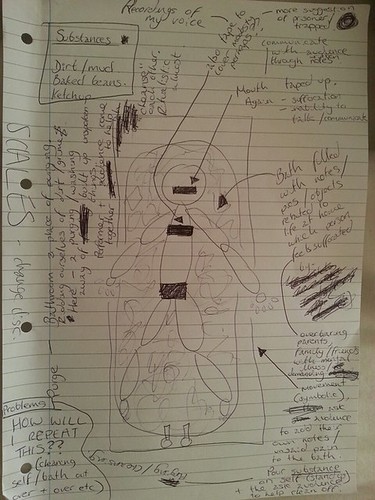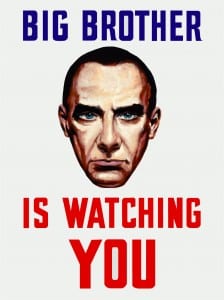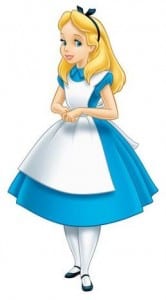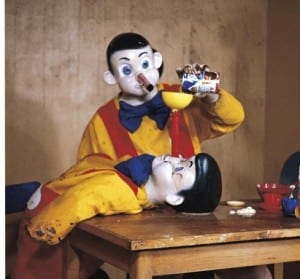“Perhaps what is most interesting in Baker’s work, an ingredient of the adjective ‘incomparable’, is that her work cuts across any strong distinction between the visual and the performing arts.” ((Barrett, Michele and Bobby Baker (2007), Bobby Baker: Redeeming Features of Daily Life, USA: Routledge, p.3)).
Bobby Baker’s, The Kitchen Show was something I found particularly interesting to watch. Her performance was of her in a kitchen with a commentary over the top explaining what she is doing, why she is doing it, and how it makes her feel – in the style of a cooking programme. The only difference was it wasn’t about cooking in her kitchen; she was using the kitchen and items in it to create something unusual and absurd. It starts with her stirring a pan of soup with a wooden spoon. In order for her to hold the wooden spoon she decides to tape her hand in that shape so she can grip it easier. As she does this she describes it so naturally, as if it is a completely normal thing to do in a kitchen. This I found quite humorous, and as the show goes on the ‘tasks’ she does become even more outrageous. Below shows a clip of some of her activities:
dailylifeltd (2012) Kitchen Show by Bobby Baker, Online: http://www.youtube.com/watch?v=RIbzhmljz_k (assessed 3 March 2012).
Previously I have discussed ideas to change the kitchen completely, having objects in the space that aren’t meant to be in there. After watching The Kitchen Show, I very much like the idea of actually using the kitchen for what it is, with the absurdity of the rabbit being enough. I will experiment with what Bobby Baker did, using kitchen utensils in different ways, for example she tied a wooden spoon in her hair and wore a cheese grater on a piece of string around her neck, and talked about it like its normal. Someone dressed as a rabbit doing everyday tasks like making the audience cups of tea or getting them a snack to eat isn’t normal to watch, similarly to Bobby Baker’s work. It would also be quite a struggle to do everyday tasks with mitten-like hands, big rubbery feet and a giant head with limited space to see out of, and would therefore be very interesting to watch the struggle I would have to endure just to do a simple task.



